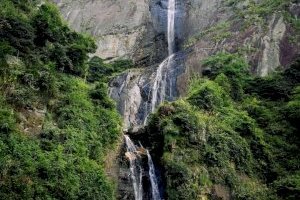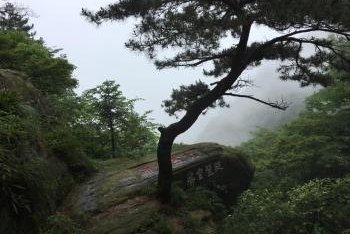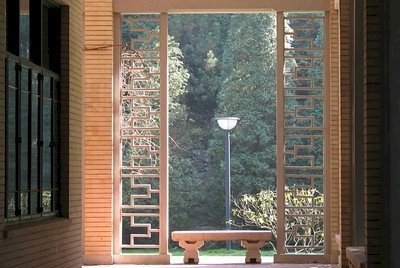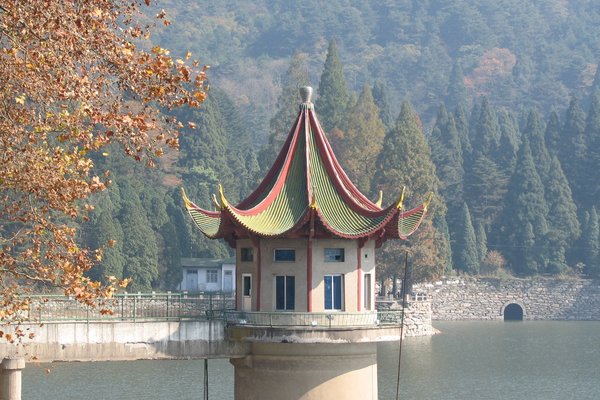China
Lushan National Park
Lushan National Park is an outstanding example of Chinese landscape culture, where temples and educational buildings have been added to the scenic landscape.
The area has attracted the cultural elite for over 1,700 years. Buddhist and Taoist temples and the Confucian White Deer Cave Academy were built. From the late 19th century, it became a summer resort for both Chinese and foreign visitors, which is reflected in the diverse architecture of the villas.
Community Perspective: This is an eclectic site. Els noticed the Communist Party links (and Mao’s bathroom), Stanislaw saw the park from above and a lot of inscriptions, and Dwight explored the more remote parts, including 11th-century Guanyin Bridge, Lushan waterfall, and White Deer Cave Academy.
Site Info
Official Information
- Full Name
- Lushan National Park (ID: 778)
- Country
- China
- Status
-
Inscribed 1996
Site history
History of Lushan National Park
- 1996: Criteria
- Proposed as a Mixed WHS by China, but at Bureau meeting in Merida this was rejected: "The Bureau also decided not to recommend the inscription of the property on Natural Criteria"
- 1996: Inscribed
- Inscribed
- Type
- Cultural
- Criteria
- ii
- iii
- iv
- vi
Links
- UNESCO
- whc.unesco.org
- Related
-
- travelchinaguide.com — Travel China Guide
All Links
UNESCO.org
- whc.unesco.org — whc.unesco.org/
Related Resources
- travelchinaguide.com — Travel China Guide
News Article
- Sept. 30, 2018 scmp.com — Chinese complain as foreigners get free entry to Jiangxi’s top tourist sites
- Sept. 11, 2009 news.xinhuanet.com — Mercedes-Benz donates 3 million yuan to protect Mount Lushan. Part of the donation will be spent repairing more than 600 broken-down villas on the mountain. The homes were built by foreigners before the 1920s in a myriad of styles including Russian, British, French, German, Italian, Japanese, and others.
Community Information
- Community Category
- Cultural Landscape: Associative
Travel Information
Recent Connections
-
Perfect Inscriptions
1996 -
Yangtze Basin
-
Notable Bridges
"Guanyin Bridge, a stone arch bridge wi…
Connections of Lushan National Park
- Individual People
-
-
Mao was here
"During the 1930s and 1940s it was the Official Summer Capital of the Republic of China, and with the establishment of the People's Republic in 1949 it was the venue for meetings of the Central Committee of the Chinese Communist Party under the chairmanship of Mao Zedong on no fewer than three occasions" - There are five more recent buildings within the park, in stone and concrete, dating from 1934 to 1970. The two later ones were the residences of Mao Zedong (1960) and Lin Biao (1970).- AB document
-
- Geography
- Trivia
-
-
Built or owned by Americans
Several villas were built by Americans (particularly missionaries) in the late 19th/early 20th century (see 359, 286 and 442 in the link). -
Built or owned by Japanese
Japanese villa -
Built or owned by British
Meilu Villa built by Lord Lannoze in 1903
-
- History
-
-
Summer residences
"In addition there are around 600 villas built by Chinese and foreign visitors in the late 19th and 20th centuries, when the area became a popular resort and was, during the 1930s and 40s the official Summer Capital of the Republic of China." (UNESCO) -
Neolithic age
"Archaeological sites include the large Neolithic village of Tingzi Dun (4th millennium BC), the farming, hunting and fishing settlement of the Shang and Zhou dynasties of Fanzhou Yan (1600-1000 BC), the residences of Tao Yuan-Ming, who moved several times during his lifetime (365-427), and the battlefield of Boyang Lake (Three Kingdoms Period, 220-65)." - Nomination File
-
- World Heritage Process
-
-
Perfect Inscriptions
1996 -
Cultural sites rejected for Natural criteria
In 1996 China asked for a "mixed" inscription but the site was only inscribed on cultural criteria
-
- Religion and Belief
-
-
Confucianism
There is a Confucian academy located at Lushan, the White Deer Grotto Academy -
Pagoda
Construction of the seven-storey brick West Grove Pagoda began around AD 730, during the Jin Dynasty.- AB Document -
Buddhist Pure Land
"The Donglin Temple (East Grove Temple), built by eminent monks in the Eastern Jin Dynasty, was the birthplace of the Jintu (Pure Earth) Sect of Buddhism." - AB document -
Taoism
Lu Xiujing built the Simplicity and Tranquillity Temple as the repository of Taoist scriptures
-
- Human Activity
- Constructions
-
-
Suspended cable cars
replaces a bus service that covered a very winding, 15-kilometer road to Lushan / 2017 / 2864m, 7.5 min / China’s very first tricable ropeway, built by Swiss/Austrian company Doppelmayr Garaventa -
Notable Bridges
"Guanyin Bridge, a stone arch bridge with a rabbet and mortise structure, has played a very important role in Chinese bridge building." (crit iv)
-
- WHS on Other Lists
- Timeline
-
-
Built in the 4th century
OUV = "associations with Chinese spiritual and cultural life", "The oldest of the cliff inscriptions is in the calligraphy of the great pastoral poet of the Jin Dynasty, Tao Yuan-ming (365-427)" and for the East Grove Temple (AD 386)
-
- Science and Technology
-
-
Confucian Academy (Shuyuan, Seowon, Shijuku)
Bailudong-shuyuan (White Deer Cave Academy) -
Botanical Gardens
Lushan Botanical Garden
-
- WHS Names
-
-
Named after a Mountain
Mount Lu (1,474 m)
-
News
- scmp.com 09/30/2018
- Chinese complain as foreigners get…
- news.xinhuanet.com 09/11/2009
- Mercedes-Benz donates 3 million yu…
Recent Visitors
Visitors of Lushan National Park
- Alexander Lehmann
- Alex Goh
- Alex Marcean
- alicemears
- Atila Ege
- Bill Koo
- Bin
- Boj
- Bram de Bruin
- chenboada
- chenqtao
- Christravelblog
- Dwight Zehuan Xiao
- Els Slots
- Fan Yibo
- Fmaiolo@yahoo.com
- Helios
- henryjiao18
- Iain Jackson
- Jeffrey Chai
- Joel on the Road
- Joyce van Soest
- jxrocky
- KarenBMoore
- Knut
- lichia
- Lucas Del Puppo
- Luke LOU
- maryhattie
- MaYumin
- Miloš Tašković
- Patrik
- Pchxiao
- Risson
- Roman Bruehwiler
- Sergio Arjona
- Shandos Cleaver
- Shijie ZHU
- Ssong.x
- Stanislaw Warwas
- Taotao Chen
- Thomas Buechler
- Tinamu
- Tingying He
- Vanessa Buechler
- Vincent Cheung
- voyager
- Weecheng
- Xiong Wei
- Xiquinho Silva
- Yang Chengyu
- Yongcheng Liu
- Zhenjun Liu
- Zoë Sheng
- Zos M
Community Reviews
Show full reviews
Time for my first review! I didn’t start writing my own reviews because a lot has been told about most of the WHSs by fellow WH lovers, and there’s really not much to add. Great job, guys! However, judging from the only reviews on Lushan by Els and Stanislaw, I suspect that most people might have missed the highlights of this site, and feel obliged to share my experience with it. Hopefully it will give you an alternative perspective of this great mountain that has become an integral part of Chinese culture over 2,000 years of history.
First, some background information. The name of Lushan was first used in Shiji (Records of the Grand Historian) around 94 BC, to describe the shape of the mountain as dwelling of the immortals. Since then, countless literary works have depicted and praised this mountain, and many architecture and inscriptions have been added to it. If there was tourism in ancient China, Lushan would have been a top 5 destination. Lushan served briefly as the summer capital of Republic of China in the 1930s and witnessed several important conferences of the Chinese Communist Party in the second half of the 20th century.
Before we start, I need to point out that tourism in Lushan is rather poorly administered and causes quite some confusion even for Chinese visitors. If you arrive by train, you should get off at the station of Jiujiang instead of the station of Lushan (a typical complexity caused by …
Keep reading 0 comments
Visited June 2017. Lushan National Park is located in the northern part of Jiangxi province and can be easily reached from the city of Jiujiang; there are many buses and minibuses from the long-distance bus station, at least one every hour till 6 pm. (Jiujiang is also a good starting point for the trip to Poyang Lake/Nature Reserve, on Chinese tentative list, already deferred at the beginning of ’80, and re-submitted in 1996.) The entry fee for the park is 180Y – you have to pay it while still in the bus, at the main gate to the park. The bust stop is located in Gulingzhen village, where there are also many places where you can spend a night or two (we slept in one of these old villas and recommend choosing a villa instead of hotels), shops and restaurants. By the bus station you’ll see a huge tourist information centre with a very big UNSESCO sign above the entrance and… no one speaking English, French or any other language but Chinese.
The park is pretty big and if want to get as more as possible from it, you’ll at least two days. But if you just want to thick it on your list, one day is enough to see the most important places/monuments, but be ready for a long and sometimes very steep walking. You can hire a taxi but remember that here everything is more expensive than anywhere else in the area or take one of two tourist …
Keep reading 0 comments
(Mount) Lushan can be accessed by a 22 kilometer long curved road from Jiujiang. Lushan is an eclectic site, and not having found much information about it in my guidebook or on the internet, I started by buying a map at the local bookstore. It had many places marked on it but I could find only a couple of the sites named in the WH nomination.
As I have seen enough of sacred mountains (and their cable cars and turtle rocks) over the past weeks, I decided to focus on Lushan’s villas. These were built here from 1895 onwards by Europeans and Americans, turning Guling (the little town on Mount Lushan) into an internationally known summer resort.
The Meilu villa is the one closest to the bus station. It was constructed in 1903 by a Lord Reynolds and later used by Chang Kai-shek. You can get inside. Further down the road, there are many other fine villas, like the Williams house and notably the group built by American missionaries. Walking around in this area does feel like you’re not in China anymore (the traffic in and around town is pleasantly low too).
On the other side of the valley there are more natural or traditional Chinese sights. What to think of the Three Ancient Trees? The three (one gingko and two cryptomeria) were reportedly planted in the 3th-5th century and stand now 39 meters tall.
A subject only slightly touched at the ICOMOS evaluation of this …
Keep reading 0 comments
